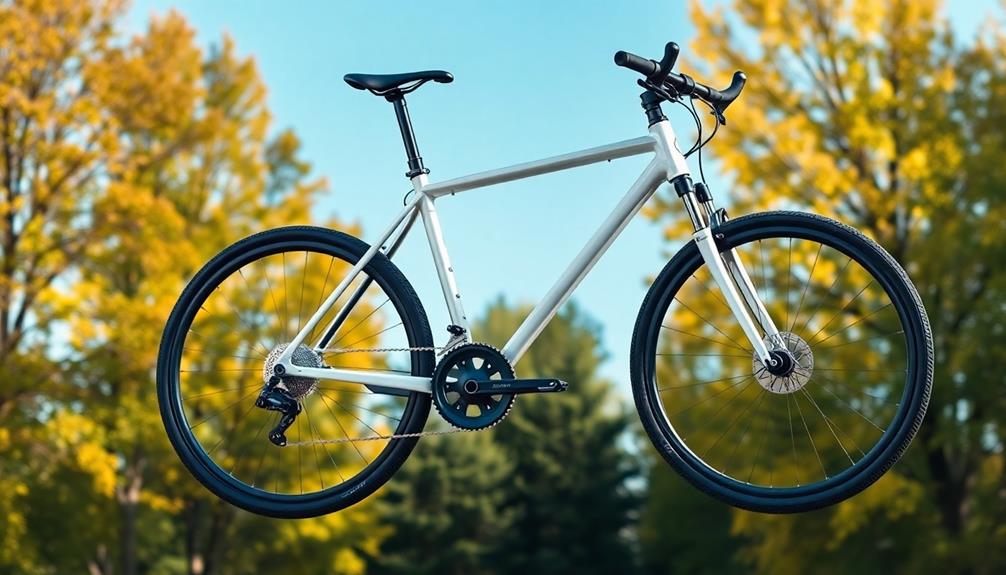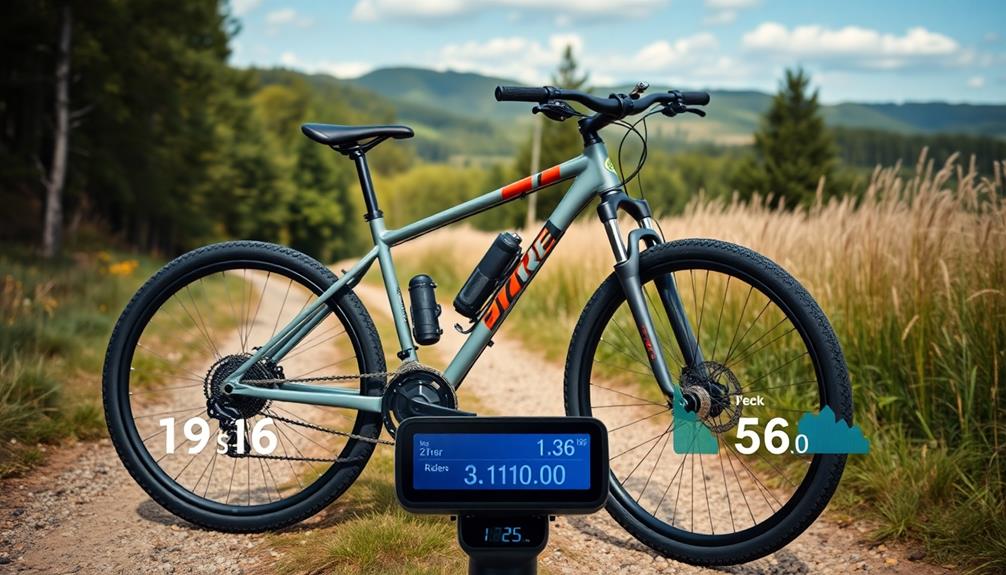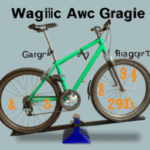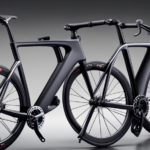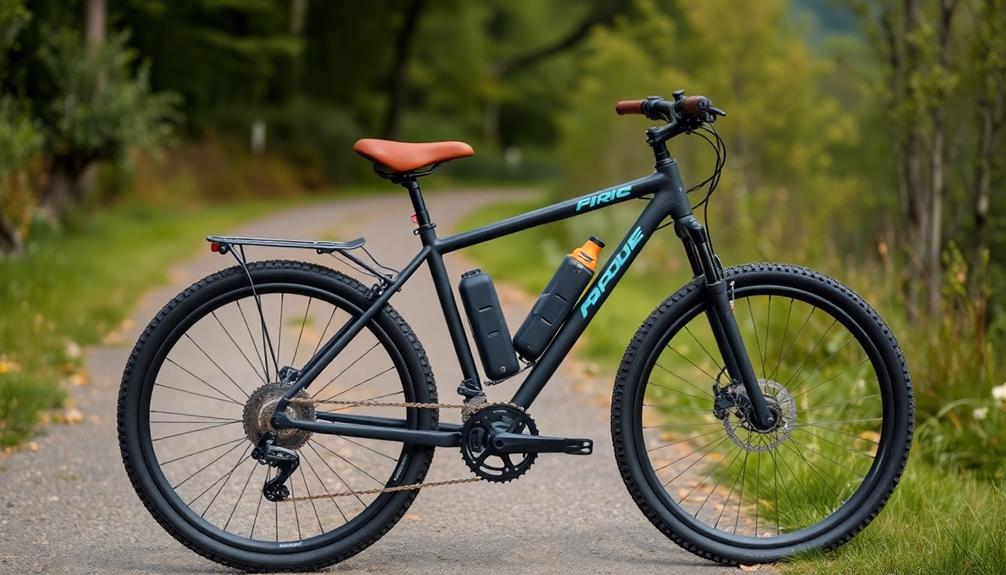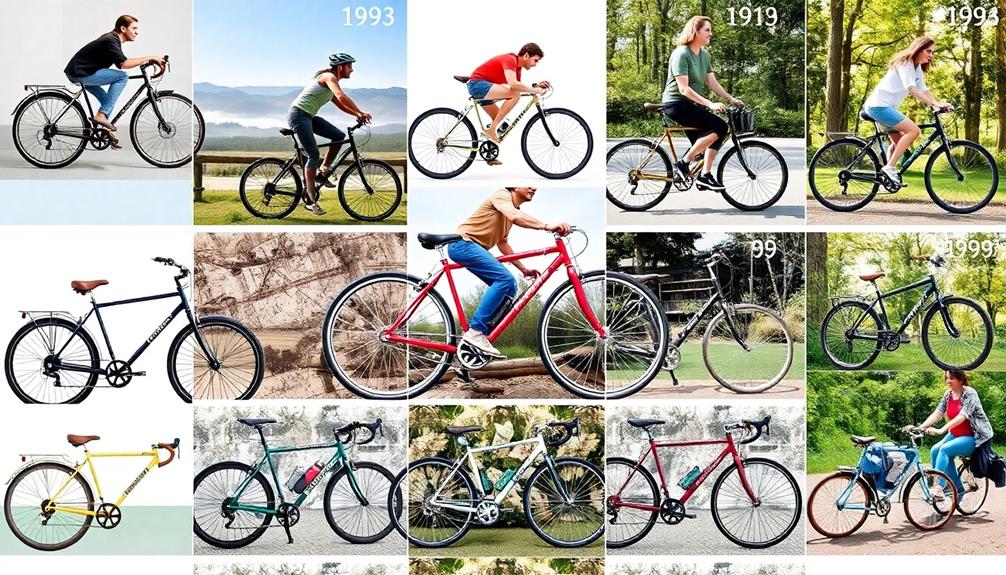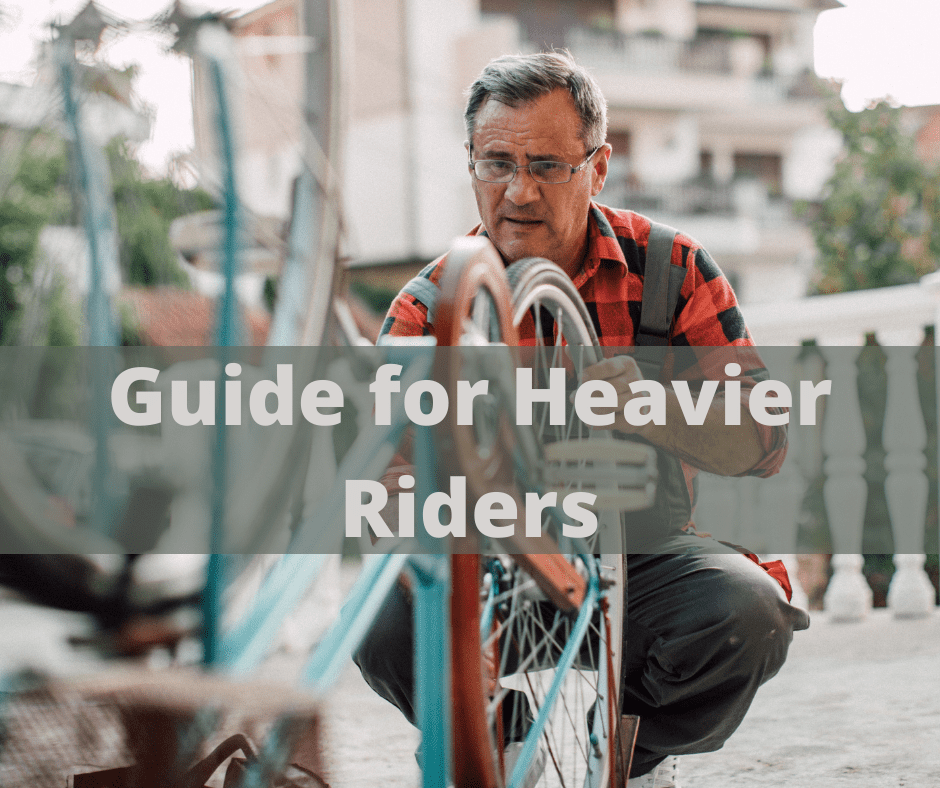To reduce the weight of your hybrid bike, start by upgrading key components. Consider lightweight wheels, as they can save significant grams and improve performance. Swapping out your tires for lighter options and choosing a carbon seatpost will also help. Don't forget about inner tubes; latex or tubeless setups can shed weight. Remove unnecessary accessories, and verify you're using efficient braking systems. Regular maintenance to check for worn parts and optimizing your setup can further enhance performance. By making these changes, you'll enjoy a more responsive ride, and there's plenty more to explore on achieving an ideal bike weight.
Key Takeaways
- Upgrade to lightweight wheels and tires to significantly reduce bike weight and improve handling performance.
- Replace heavy components like the seatpost, saddle, and handlebars with lighter materials such as carbon.
- Remove unnecessary accessories, such as kickstands and racks, to streamline your bike's overall weight.
- Consider switching to lightweight inner tubes, such as latex or tubeless options, for better performance and weight savings.
- Evaluate and upgrade braking systems to lighter disc brakes and components for additional weight reduction.
Understanding Hybrid Bike Weight
Understanding the weight of your hybrid bike is essential for optimizing your riding experience. The average bike weight for hybrids typically ranges from about 15 lbs for high-end models to 40 lbs for full suspension variants.
If you're riding an aluminum-framed hybrid, expect it to weigh between 28-30 lbs, while specialized models like the Specialized Sirrus Pro can weigh as little as 19.5 lbs. Additionally, considering a lightweight electric bike conversion kit can enhance your bike's performance without adding significant weight.
To save weight, consider the frame material. Aluminum is generally lighter than steel, impacting your bike's overall weight and performance. Heavier hybrids often exceed 30 lbs, especially those equipped with steel frames or added accessories like racks and fenders.
A well-balanced bike weight should ideally be around 18% of your body weight, though you might still ride effectively with a heavier bike.
Assessing Current Components

To effectively reduce the weight of your hybrid bike, start by evaluating the current components that contribute to its overall heft. Begin by weighing your bike to establish a baseline. This helps you identify which parts are the heaviest.
Next, assess your frame material. Aluminum frames generally weigh less than steel ones, so consider upgrading if you're using steel.
You should also evaluate your wheels. Stock wheels can be considerably heavier than aftermarket options, with some lightweight wheels saving upwards of 500 grams.
Don't forget to review your tires and inner tubes. Switching to lightweight tires like the Continental Grand Prix 4000 S II and latex inner tubes can save over 100 grams, enhancing ride quality.
Finally, examine any accessories like kickstands, racks, and fenders. These components can add unnecessary weight. Removing or replacing them with lighter alternatives can streamline your bike further.
| Component Type | Weight Reduction Potential |
|---|---|
| Frame (aluminum) | Up to 1 kg |
| Wheels (aftermarket) | Up to 500 g |
| Tires & Tubes | Over 100 g |
Lightweight Wheel Upgrades
Upgrading to lightweight wheels is one of the most effective ways to reduce your hybrid bike's weight and enhance its performance. By switching from stock alloy wheels to lightweight options, you can save significant weight while improving your ride quality.
For those looking to maximize their bike's efficiency, contemplating Toyota Tacoma 2007 Tuning can offer insights into performance upgrades. Here are some top lightweight wheelset options to contemplate:
- Cadex 42: Weighing just 1,265g, these wheels can save up to 500g compared to heavier entry-level models.
- Roval Alpinist: At 1,248g, this high-quality wheelset not only reduces overall bike weight but also boosts acceleration and handling.
- Campagnolo Zonda: A cost-effective choice, these wheels save approximately 225g compared to heavier stock wheels while maintaining performance.
- Shimano RS 11: These stock wheels are often heavier, detrimentally affecting your bike's overall performance, making them prime candidates for an upgrade.
Investing in a lightweight wheelset can truly transform your cycling experience. Lighter wheels decrease rotational mass, making climbing and sprinting more efficient, allowing you to ride faster and with more agility.
Don't underestimate the impact of a good wheel upgrade!
Choosing Performance Tires

Selecting the right performance tires can greatly impact your hybrid bike's weight and overall efficiency. Upgrading to lightweight performance tires, like the Continental Grand Prix 4000 S II, can save you around 100 grams while improving rolling resistance and ride quality.
When you're on the hunt for tires, aim for options that weigh between 200-300 grams, leaning towards the lower end to maximize weight savings. Additionally, understanding how GMC tuning techniques can enhance performance might inspire you to apply similar principles when optimizing your bike.
Furthermore, consider using lightweight inner tubes, such as latex tubes, which can reduce weight by about 48 grams compared to standard butyl tubes. This combination not only helps reduce weight but also enhances your bike's comfort and performance.
However, keep in mind that lighter tires may sacrifice some durability and puncture resistance, so assess your riding habits before making a choice.
Seatpost and Saddle Options
Replacing your stock seatpost and saddle can lead to considerable weight savings while also improving your bike's comfort and performance.
Upgrading these components not only helps you shed unwanted grams but also enhances your riding experience. Local Audi performance tuning can provide insights into how weight reduction can improve overall handling.
Here's how you can make effective choices:
- Choose a Carbon Seatpost: Options like the Ultimate USE Evo 3k Carbon seatpost can save substantial weight compared to standard aluminum models, often exceeding 100 grams.
- Opt for a Lightweight Saddle: Consider lightweight saddle choices such as the Fizik Antares (153g) or Cadex Boost (135g). These can considerably contribute to overall weight saving and boost comfort.
- Prioritize Ergonomics: Modern saddles are designed for both weight saving and improved rider comfort, making them a smart investment.
- Combine Components: Pairing a lightweight seatpost with a performance-oriented saddle not only reduces overall weight but also enhances your bike's responsiveness.
Handlebar and Stem Modifications

To lighten your bike, consider swapping your alloy handlebars for carbon-fiber options, which can save you up to 80 grams.
Many cycling enthusiasts also explore Volkswagen TDI Tuning to enhance performance, and similarly, reducing weight on your bike can lead to improved acceleration and handling.
Upgrading to a lightweight stem, like the Kalloy Uno, can further reduce weight while maintaining strength.
These modifications not only enhance performance but also improve your overall riding experience.
Carbon Handlebar Benefits
Upgrading to carbon handlebars can greatly lighten your hybrid bike while enhancing its overall performance. By swapping out your alloy handlebars for carbon ones, you can achieve approximately 80 grams in weight savings, making a noticeable difference in how your bike handles.
Additionally, a lighter bike improves acceleration and climbing efficiency, much like how high refresh rates enhance gaming experiences. Here are some benefits of going with carbon handlebars:
- Weight Reduction: Carbon handlebars, like the Fizik Cyrano R1 Bull Carbon bar, weigh around 200 grams, striking a great balance between weight and strength.
- Improved Comfort: Carbon has unique properties that help absorb vibrations, leading to a more comfortable ride.
- Enhanced Performance: A lighter bike accelerates better and climbs more efficiently, especially on longer rides.
- Customization Possibilities: If you decide to cut the handlebars for further weight savings, just be cautious as it may affect usability and comfort.
Additionally, consider using thin cork handlebar tape instead of thicker options to shed even more grams without sacrificing grip.
Lightweight Stem Options
When considering lightweight stem options for your hybrid bike, you'll find that even small changes can lead to significant weight reductions and improved performance. Upgrading to a lightweight stem, like the Kalloy Uno, which weighs under 100g, can help you save some weight compared to the heavier stock stems.
Additionally, utilizing best ways to patch an air mattress can enhance your overall bike maintenance. Pair this with carbon fibre handlebars, such as the Fizik Cyrano R1 Bull Carbon, to shed up to 80g over standard alloy options.
You can also trim down excess length on your handlebars, but remember to balance weight savings with comfort and usability. Additionally, consider switching to lightweight handlebar tape, like the Deda Traforato Perforated Bar Tape at just 29g, which adds to your overall lighter setup.
Don't overlook the bolts, either. Replacing heavy steel bolts with lightweight alloy bolts can save additional grams while maintaining the integrity and performance of your components.
Inner Tube Alternatives

If you're looking to shed some weight from your hybrid bike, consider switching to lightweight inner tubes.
By enhancing the overall performance of your bike, you can improve efficiency during rides, especially in urban environments where quick changes are essential commuting efficiency.
Latex tubes not only reduce your bike's weight but also improve ride quality, while tubeless setups can eliminate the need for tubes entirely.
Explore options like Tubolito Tubo or Pirelli P Zero Smartube to find the best fit for your needs.
Latex Tube Benefits
One of the best ways to lighten your hybrid bike is by switching to latex inner tubes. These tubes weigh about 80 grams less than standard butyl options, which contributes notably to weight reduction. Not only do latex tubes help you shed pounds, but they also enhance your bike's performance.
Additionally, opting for eco-friendly materials can further support your commitment to sustainability while cycling. Here are some key benefits to evaluate:
- Improved Ride Quality: Latex tubes are more flexible, absorbing road vibrations better than traditional tubes, leading to a more comfortable ride.
- Reduced Rolling Resistance: With less friction, latex tubes can boost your speed and efficiency, making them ideal for competitive riding.
- Weight Reduction: The lighter weight of latex tubes directly impacts your bike's overall weight, making it easier to handle.
- Regular Maintenance: To maximize their advantages, verify proper inflation and timely replacement, as latex tubes can lose air faster than butyl ones.
Although they're more prone to punctures, many cyclists find that the trade-off for increased performance and reduced weight is well worth it.
Evaluate making the switch to latex tubes for a noticeable difference in your riding experience.
Tubeless Setup Advantages
Switching to a tubeless setup can greatly enhance your hybrid bike's performance while also shedding weight. By eliminating the inner tube, you can save about 50-100 grams with tubeless-ready tires compared to standard ones. This weight reduction not only helps in accelerating your bike but also improves overall handling.
Additionally, embracing a sustainable energy practice can promote a more eco-friendly cycling experience, similar to how wood-burning stoves support responsible forestry practices.
Another major advantage of a tubeless setup is the ability to run lower tire pressure. This enhances traction and comfort, especially on varied terrain, while considerably reducing the risk of pinch flats. With less rolling resistance, you'll notice improved speed and efficiency, making your rides smoother and more enjoyable.
Additionally, the use of tubeless sealant plays an essential role in preventing air leaks and punctures, allowing you to opt for lighter, more supple tires without sacrificing reliability. This means you can push your limits on the road or trail without worrying as much about tire issues.
Incorporating a tubeless setup into your hybrid bike not only contributes to notable weight reduction but also enhances your overall riding experience. It's a smart upgrade that combines performance and comfort for any cyclist looking to get the most out of their bike.
Lightweight Tube Options
After optimizing your bike with a tubeless setup, exploring lightweight tube options can further enhance your hybrid bike's performance. Switching from standard butyl inner tubes to latex tubes can save you about 80 grams per pair, improving ride quality due to lower rolling resistance.
However, keep in mind that while latex tubes offer significant weight savings, they may not be as puncture-resistant as heavier options.
Here are four lightweight inner tube alternatives to evaluate for effective weight reduction:
- Latex Tubes: Provides a substantial weight decrease but trades off some durability.
- Tubolito Tubo: A super lightweight choice, some models weigh as little as 40 grams each.
- Pirelli P Zero Smartube: Another excellent lightweight option, maintaining performance while reducing weight.
- Standard Butyl Tubes: While heavier, they can be a more puncture-resistant option if you ride in rough conditions.
Investing in lighter inner tubes is a cost-effective strategy, usually costing less than $30.
This upgrade can contribute to an overall weight reduction of around 48 grams compared to standard tubes, making your ride feel even better.
Evaluating Braking Systems

Regularly evaluating your braking system is essential for both performance and weight reduction on your hybrid bike.
One effective way to shed weight is by upgrading from traditional rim brakes to lighter disc brakes. Disc brake systems often use lighter materials, eliminating the need for heavier brake calipers associated with rim brakes.
Next, consider the brake rotors. Replacing stock rotors with lighter options can greatly impact weight; for instance, moving from 160mm rotors weighing around 280g per pair to lighter variants can save you up to 50g.
Don't overlook the brake cables, either. Swapping out heavy cables and housing for lighter alternatives can reduce weight by approximately 30-50 grams, depending on the length of the cables used.
Lastly, utilizing lightweight brake pads can contribute to your weight savings. Switching from standard pads to lightweight carbon-specific pads can save an additional 20-30 grams.
Regular maintenance and adjustment of your braking system guarantee ideal performance and prevent unnecessary weight from worn components, helping you focus on those critical weight reduction goals while enjoying a smoother ride.
Practical Weight Reduction Tips

When you're looking to shed some weight from your hybrid bike, optimizing component selection is key.
Upgrading to lightweight materials and minimizing unnecessary accessories can make a noticeable difference in performance.
Let's explore some practical tips to help you achieve those weight savings effectively.
Optimize Component Selection
Your bike's performance can greatly benefit from optimizing component selection, leading to a lighter and more responsive ride.
By choosing lightweight options for key components, you can considerably reduce weight and enhance your cycling experience. Here are some effective ways to achieve this:
- Wheels: Upgrade from heavy alloy wheels to carbon or high-quality aluminum wheels, saving up to 500 grams and improving ride quality.
- Inner Tubes: Switch to latex tubes instead of standard butyl. This can save around 80 grams while boosting comfort and ride responsiveness.
- Handlebars: Replace your stock handlebars with lightweight carbon-fiber alternatives, such as the Fizik Cyrano R1 Bull Carbon bar, which can save you up to 80 grams without compromising strength.
- Seatpost: Install a lightweight seatpost like the MT Zoom Ultralight, which can cut approximately 100 grams compared to standard aluminum options.
Upgrade to Lightweight Materials
Upgrading to lightweight materials can make a considerable difference in your hybrid bike's overall performance and handling. The right materials can help you make your bike lighter, enhancing your ride experience.
Start with a carbon fiber seatpost; it can save you about 100-150 grams compared to standard aluminum. This simple swap greatly reduces the overall bike weight.
Next, consider replacing heavy alloy handlebars with lightweight carbon options, like the Fizik Cyrano R1 Bull, which can trim around 80 grams. Switching to lightweight latex inner tubes instead of standard butyl tubes can also help you shed about 80 grams, improving both comfort and ride quality.
Lightweight wheels, such as the Campagnolo Zonda, are another fantastic option, offering approximately 225 grams in weight savings that can boost your acceleration and climbing efficiency.
Minimize Unnecessary Accessories
Reducing the weight of your hybrid bike can be as simple as minimizing unnecessary accessories. Every little bit counts, and by being strategic about what you carry, you can make your ride considerably lighter.
Here are some practical tips to help you minimize unnecessary accessories:
- Remove non-essential items: Kickstands, heavy fenders, or decorative components can add substantial weight. For example, a standard kickstand weighs about 250-300 grams.
- Opt for lightweight water bottle cages: Replace standard cages with lighter materials like carbon or aluminum to save approximately 50-100 grams each.
- Use compact repair kits: Instead of bulky toolsets, utilize lightweight multi-tools or small repair kits, potentially saving over 100 grams.
- Choose minimalistic handlebar tape: Thin cork tape can reduce weight by up to 20 grams compared to thicker options.
Additionally, regularly assess your bike's cable lengths and trim any excess, which can save another 20-50 grams.
Maintenance for Optimal Performance

To keep your hybrid bike performing at its best, regular maintenance is key. Start by inspecting your bike for worn or heavy components. Replacing these can greatly enhance overall performance and reduce weight.
Keeping your bike clean is also essential; dirt and grime can accumulate, adding unnecessary weight and impacting performance. A thorough wipe-down can prevent this issue.
Ensure all parts are functioning efficiently. Poorly maintained components can create excess strain, leading to performance declines and potentially costly repairs. Take time to reassess your bike setup periodically. Look for weight-saving opportunities, like trimming excess cable lengths or removing accessories you don't need.
Stay informed about new lightweight technologies and products in the cycling market. Upgrading to newer materials and components can offer considerable performance benefits without adding weight.
By prioritizing maintenance, you're not just keeping your bike clean; you're actively improving its efficiency and reducing weight. Ultimately, these efforts can lead to a smoother ride and a more enjoyable cycling experience.
Regular maintenance is your best ally in maintaining peak performance and achieving a lighter hybrid bike.
Frequently Asked Questions
How Can I Make My Bike Weigh Less?
To make your bike weigh less, consider upgrading to lighter wheels and tyres, swapping standard tubes for latex, replacing heavier components with carbon alternatives, and minimizing unnecessary accessories. Every little change adds up!
How Much Should a Hybrid Bike Weigh?
A hybrid bike typically weighs between 15 to 40 lbs, depending on materials and design. Ideally, it should be around 18% of your weight, but personal preferences and experiences may allow for some flexibility.
How Can I Reduce the Weight of My Motor Bike?
To reduce your motorbike's weight, consider swapping out heavy components for lightweight alternatives, like alloy wheels and carbon parts. You can also check for unnecessary accessories and streamline your setup for better performance.
How Can I Make My Bike Lighter for Free?
Imagine gliding effortlessly, your bike feeling almost weightless beneath you. You can trim excess cable lengths, ditch unnecessary accessories, and even remove valve caps. Each small change adds up, making your ride lighter without spending a dime.
Conclusion
By focusing on thoughtful tweaks, you can considerably slim down your hybrid bike. Swapping out stock components for lighter alternatives, selecting speedy tires, and simplifying your braking system all contribute to a sleeker ride. Remember, every ounce counts! With regular maintenance and mindful upgrades, you'll not only enhance performance but also enjoy a more exhilarating experience on the road. So, gear up for a lighter, livelier journey every time you pedal!
